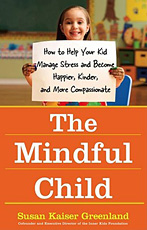Sending Friendly Wishes
"My favorite classical practices cultivate good will, and they were some of the first that I shared with children. But when I moved from working exclusively with older children to working with four-year-olds, I needed to find a name for them that described what we were doing in a way that very young children could relate to and understand. I turned to early-child-care educator Gay Macdonald, who has over twenty-five years of experience teaching preschool children and has approximately 350 children in her charge every year in the five early-child-care facilities at UCLA. She suggested I talk about loving-kindness in the context of friendship. From that conversation, the practice of sending friendly wishes was born.
"There are opportunities for friendly wishes practices hidden in every aspect of life, and they are limited only by your imagination. Teachers and parents I've worked with have woven friendly wishes into everyday activities, inspired by swimming pools, rock concerts, and quiet secluded forests. I encourage you to look to the people, places, pets, and other living things that have been meaningful in your lives and use those memories as silk ribbon from which you can weave your own friendly wishes. To help get you started, here's a general framework inspired by classical loving-kindness practice, but modified for young children whose minds, due to their developmental stage, may still struggle with abstract concepts.
• "Ask your children to send friendly wishes to themselves, imagining that they are happy and having fun, that they're healthy, and that they're safe with their family and friends.
• "Next, suggest they choose a friend or family member, hopefully someone in the room with them, and silently send friendly wishes specifically tailored for that person. For example: 'Daddy, I want you to be happy; I hope all your dreams come true; I want you to be healthy and strong; I want you to feel lots of love in your life; I want you to get home from work early so you can play with me; I hope you feel peaceful and calm; I want you to be safe always.'
• "After sending friendly wishes to someone they know, preferably someone in the room with them, suggest they send friendly wishes to people who aren't in the room, starting with their family and friends, then moving to people they've met, those they haven't met yet but would like to meet, and finally all living things in the whole wide world. The children might imagine themselves saying to these people, place, and living things: 'I hope you're happy; I hope that you're healthy and have a lot of fun, that you're safe and never get hurt, and that you live in peace with people you love.'
• "Older children and teens can send friendly wishes to people who annoy them or who are having a difficult time. I steer clear of those practices with young children, though.
• "With young children, I close the circle of friendly wishes with the children themselves, by asking the children to internalize them again and say to themselves silently, 'May I be happy, may I be healthy and strong, May I be cozy, safe, and living in peace with my family, my friends, my pets, and all those I love.' "
